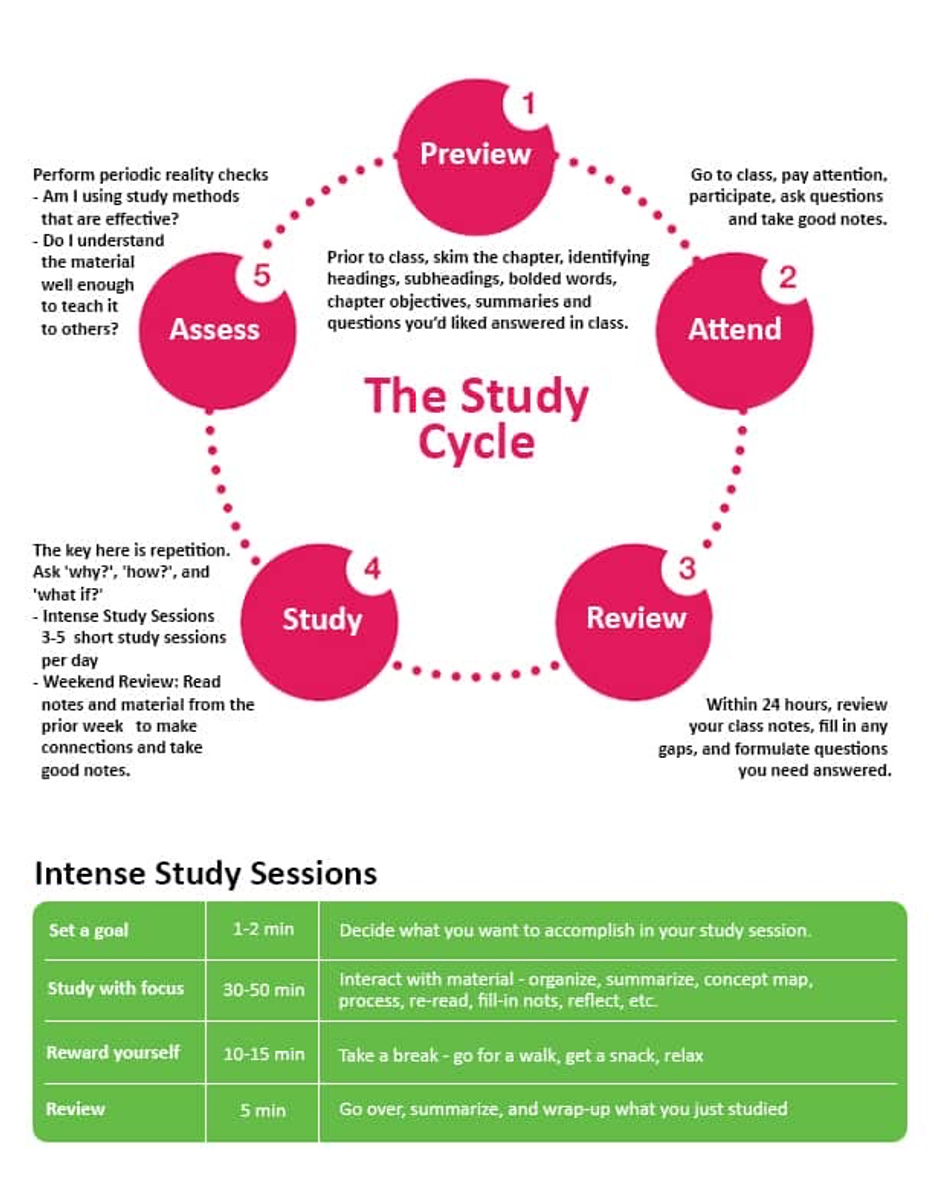The Study Cycle

The Study Cycle below is a guide to help students build effective studying into their weekly schedule. On the surface, each step may seem obvious, but all too often students take shortcuts and miss important opportunities to benefit from the interplay of each step of the cycle.
The Study Cycle is a 5-step approach to learning designed to help students become more efficient learners. It works the way your brain learns best. It reinforces new content and builds confidence. The Study Cycle can be easily adapted to any coursework. In the Study Cycle, each step builds on the previous one and distributes learning. Each step feeds into both the previous and following steps.
Step 1- Preview
Preview the information before the teacher starts teaching the content. Skim the material and read only the headers, subheadings, and highlighted text. Take a look at what you’ll be covering during the upcoming classes. This will help you gain a sense of the big picture and anticipate how concepts fit together. You will get more out of the class as you already have some context for what you’re about to learn, and you can come into class with questions that you expect will be answered.
Make sure to do the pre-class reading. Even if your teacher does not specifically assign reading or an Edrolo video, you can use your developmental rubrics, textbooks and unit outlines to find out what will be covered and preview the content.
If you’re pressed for time, it is okay to skim—focus on headings, introductions, pictures, data and summaries. Even read over the PowerPoint slides ahead of time. The important thing to keep in mind here is that neither skimming, reading, nor attending class is incredibly effective on its own, but the combination (and sometimes repetition) with the next steps is highly effective in getting ahead. Once you have developed the big picture, it will be much easier to remember and learn the details.
Ask yourself questions related to the upcoming topic:
- What do I need to learn? What knowledge and skills from the developmental rubric do I need to learn?
- What do I already know about this topic?
- What are the next steps in my learning based on the developmental rubric?
Note Taking - Before Class
Get ready to take notes before class.
Review your notes from the previous class session before you come to class. This will help you remember what was covered and get you ready to understand new information your teacher provides. Complete all assigned readings before you come to class. Your teacher will expect that you have done this and will use and build upon this information. Bring all note taking materials with you to class. Have several pens and pencils as well as your notebook ready to go.
Step 2- Attend
Of course, going to class is an important and obvious step in the study cycle, but just being physically present isn’t enough. Missing even a few classes can be detrimental to your studies and learning. Being attentive and engaged will help you get the most out of the experience. Class time is important, because this is when you get an understanding of what you need to learn, how you need to learn and importantly determine what your next steps in learning are.
Make the most of your Class Time! Listen and take notes. Especially when you hear things like: “You’ll need to know this for your exams” or “This will be in the assessment task” or “This is critical” or “You need to know this”.
It is often in the in-class discussions that teachers give you hints on what to expect in exams and assessments.
Note Taking - During Class
During class, take notes in a way that will be useful to you. Taking notes by hand can help you remember the information—especially if you try to paraphrase in your own words. Keep track of your questions, and if you don’t get to ask them during class, make a plan to ask a peer, the teacher after class / or in the next class or post your question on Teams.
Importantly, read the information that is required of you and determine what you need to know based on the success criteria and 'I can' statements in the developmental rubric.
Keep your attention focused on what your teacher is saying. Listen for “signal statements” that tell you that what your teacher is about to say is important to write in your notes. Examples of signal statements are “The most important point...” and “Remember that...”. Be sure to include information that your teacher repeats or writes on the board in your notes.
Write quickly so that you can include all the important information in your notes. Do this by writing abbreviated words such as med for medicine, using symbols such as % for percent, and writing short sentences. Place a ? next to the information in your notes which you are unsure about, and check with your teacher for clarification after class.
Step 3 - Review
Take some time after class to go back over your notes or lesson details. You don’t have to spend a long time doing this, but the sooner you do it the better (preferably that day). By reviewing soon after class, while the material is still fresh, you can fill in gaps and figure out what you might need help with. This should be based on the knowledge and skills in the developmental rubric. This process of review transfers the information you learned during class from your short-term to your long-term memory. It also reinforces new concepts and increases confidence.
When you’re reading back through your notes, make sure you’re actively engaging with the material. Passively letting your eyes scan over the material won’t actually help much. Instead, explain the material to yourself, summarize the key points, ask questions, and think about the big picture. Test yourself! Start to plan out how you might want to study the material you learned. If you’ve followed steps 1 and 2, this will be the third time you’re engaging with this content. Repeated exposure to the material helps you remember and understand it more effectively.
Note Taking - After Class
Rewrite your notes after class. Rewrite your notes to make them more complete by changing abbreviated words into whole words, symbols into words, and shortened sentences into longer sentences. Make your notes more accurate by answering any questions you had when writing your notes in class. Use your textbook and reference sources to obtain the information you need to answer your questions. If necessary, ask your teacher or other students for help.
Check your notes- Check with other students to be sure you did not leave out important information. Having good class notes will help you to be better prepared for assessments.
Being actively involved- Research indicates that the amount of information you retain after 30 days when you listen is only 10%; when you take notes it goes up to 40-50%; when you’re actively involved AND take notes it goes up to 90%.
If you don’t understand something when you are reviewing the learning, ask a friend or teacher.
Step 4 - Study (Retrieval Practice)
Schedule several focused study sessions per week for each of your classes. These sessions don’t have to be long; in fact, brief but intense study sessions tend to be more effective than trying to study for many hours at a time. Figure out how long you can stay focused and efficient—it may be just 20 to 30 minutes, but it will probably vary depending on the material—and then plan study sessions of this length throughout your week.
By spreading your studying over time, you’re studying much more effectively (this is called “distributed or spaced practice”) and won’t have to try to do less-effective marathon study sessions before the SACs and exam (also known as “massed practice”). Distributed practice helps you learn the material at a deeper level because you have more time to process it, see connections, and ask questions.
Instead of simply restudying information, attempt to recall that information from memory. This technique refers to what you should be doing to prepare for assessments (that is, test yourself via practice tests or other recall-based techniques).
Learning scientists have determined that one method is especially effective at helping you retain information and successfully retrieve it later. That method is retrieval practice.
Retrieval practice is practicing recalling information from memory.
After you have finished reading through a set of lecture slides, your notes, or the textbook, put it aside. Without looking at those materials, try to remember what you have just learned, either mentally or by writing it down. In effect, you are giving yourself a practice test. Some information will readily come to mind, and some information might not. Some materials might be completely understood, and other materials might not.
After you have recalled as much as you can remember, go back and check the course materials. Determine if the information that you recalled was correct and examine those portions that you did not fully recall or did not fully understand. Then, repeat the process.
If you have completed those steps, then you have just used retrieval practice. Retrieval practice involves recalling to-be-remembered information from memory. Retrieval practice – by itself and especially when accompanied by a subsequent check of course materials – is one of the most effective learning methods discovered to date. In fact, over 200 studies from over a century of research have demonstrated benefits of retrieval practice on memory.
How do I use retrieval practice?
There are many ways to practice retrieving information. It can be as simple as the example discussed above – put your course materials aside and simply try to recall information mentally or on a sheet of paper. Other ways to use retrieval practice include:
- Use practice tests – make your own practice questions, make and share questions with a study partner, use practice questions provided by the teacher or found in a textbook, or find questions from online sources (for example, Quizlet).
- Make flashcards – this commonly involves writing on index cards (questions on one side, answers on the reverse). You can also make flashcards on a computer and print them out or use flashcard software systems.
- Use a copy-cover-and-check method – simply cover your lecture slides, attempt to recall, and then uncover to check. Like the method discussed in an earlier section of this page, this method has the advantage of requiring little-to-no added work before you start retrieval practice.
- Answering “quiz” questions - Get a friend or family member to quiz you on key concepts. Offer to help your friends with their work too. Quizzes are great ways to get confident about what you know and find out what you still need to learn.
- Writing down all you can remember about a topic on a blank sheet
- Utilise practice tests and practice SAC: Use practice tests / SACs or questions to quiz yourself, without looking at your book or notes.
- Make your own questions: Be your own teacher and create questions you think would be on a test. If you’re in a study group, encourage others to do the same, and trade questions.
- Continue to self-assess and reflect on your work and learning using your development assessment rubrics. Self-assessment is a valuable learning tool as it can help identify your gaps in knowledge and skills, it can then assist in identifying what areas you need to focus your revision and study on, as well as help you track your own progress leading up to any exam or assessment task. You must ensure you have learnt the relevant learning intentions and success criteria after EVERY class. A question to ask yourself, what do I know and don't know?
If you know the types of questions that will be on your assessments (they are in your developmental rubric!), it can also help to perform retrieval practice using similar types of questions or to focus on retrieving the same types of information. Use the 'I can' statements as your practice questions!
If your course requires application questions (for example, applying the knowledge in another context), then consider incorporating application questions into your retrieval practice activities.
Overall, by using retrieval practice, you are increasing the likelihood that you will successfully remember relevant information during your next high-stakes SAC and exams.
Step 5 - Assess
The last step is the one that a lot of people forget about. It’s important to check in with yourself and assess, to make sure what you’re doing is working and being open to changing your techniques if it’s not. After all, you wouldn’t want to spend a lot of time doing something that is not helping you learn. Is what you are doing having an impact on your learning? How do you know? To make sure that your studying is effective, take a step back on a regular basis and ask yourself some metacognitive questions
Reflect and evaluate your mastery and understanding of the material you learned and studied. Ask yourself:
- Is the information I'm studying making sense?
- Am I confident with the new material?
- Do I understand the material well enough that I can teach it to someone else?
- Does this answer make sense given the information provided?
- What strategy did I use to solve this problem that was helpful?
- How does this information conflict with my prior understanding?
- How does this information relate to what we learned last week?
- What questions will I ask myself next time I’m working these types of problems?
- What is confusing about this topic?
- What are the relationships between these two concepts?
- What conclusions can I make?
Assessing your studying from time to time is an essential aspect of learning. Use your developmental rubric to self assess!
Regular retrieval practice is again critical in this step of the cycle! Practice self-testing on a regular basis. Discuss what you’re learning with classmates. Check in with your teachers to determine whether you are providing the evidence of learning required to meet the knowledge and skills in your developmental rubric.
| Intense Study Session | ||
Learning sprint | Time | What it looks like. |
| Set a goal | 1 -2 mins | Decide what you want to achieve in your study session. What 'I can' statement/s from your development rubric are you trying to learn? |
| Study with focus | 30 - 40mins | Retrieval practice- Interact with material. |
| Reward yourself | 10 - 15mins | Take break- go for a walk, get a snack, relax, exercise, |
| Review | 5 mins | Go over summaries and wrap up what you just studies. |
The study cycle was adapted from:
David Black
Later Years Leader

